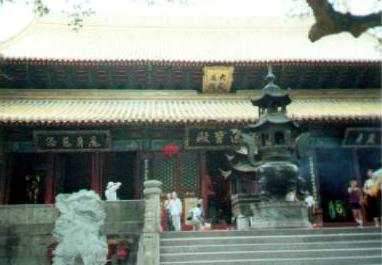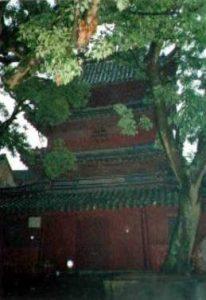
On August 6 and 7 2001 I visited the Zhejiang Nanhai Puji Temple (Chek Chian Nan Hai Pooi Chee See) on Putuoshan Island. I visited this temple in search of traces that might be left behind by either Reverend Hui Jing or Reverend Gao Can. But unfortunately there was nobody left to remember either of them; the last monks from the Qing Dynasty passed away 3 years ago. All the monks living at this moment in the temple were installed there after the rehabilitation and re-legalization of Buddhism in the beginning of the eighties. Temple records were probably destroyed during the Cultural Revolution, although research is being executed after my request. I would like to thank Reverend Shi Yan Quan of the Putuoshan Fojiao Yiyang Tong (Yangzhi Buddhist Monastery) for his warm welcome and his corporation in this matter.

The following is an description of the temple.
“The Puji Buddhist Temple. Below the Jiu peaks is the major place for worshipping the Goddess of Mercy (Guanyin) and all grand Buddhist services on Putuoshan Island are held here.
The Puji Temple is one of the three most honorable Buddhist temples on the island. It is also know as the Qian temple. It was first build in 867, i.e. the 5th year of Emperor Qiande of the Song Dynasty and is was granted Baotuo Temple for the Goddess of Mercy. It was rebuilt in the 38th year of Emperor Kangxi and was bestowed the board of Puji Spirit.
There are Dayuantong Hall, Tian Wang Dian, Hall of Buddhist Sutra’s, etc. For a thousand years the Old Putuo has witnessed great changes brought by time, experienced repeated rising and decline and has been the most famous temple in the south of China. It hold a construction area of 11 thousand square meters and it can be described as ‘a building in every 5 steps and a tower in every 10 steps’.

The magnificent Dayuantong Hall deserves the name of Great Moving Hall, since in side it is not spacious with a hundred people in and not crowded with a thousand people.
What is worshipped here is the 8.8 meters high statue of the Goddess of Mercy which is dignified and graceful. All male and female statues on both sides and 32 varying statues of the Goddess of Mercy are vivid and lifelike. They were all restored in 1981 and are of considerable art value. The Goddess of Mercy has been the most worshipped God by Buddhist devotees for thousands of years. In the harts of all Buddhists all over the world she has been the embodiment of mercy and perfection, and she can help the needy and relieve the distressed. There are so many worshippers here due to there hope and them praying for the God’s favors as well as the attraction of the masterpieces made by the artists of many generations.


The huge bronze incense burner called ‘The treasures Pot’ is hundreds of years old, but still keeps a fine luster an d shape. It is a witness to history. The huge clock of over 7,000 jin was made in the 12th year of the Jiaqing period of the Qing Dynasty. There is still an old Hu fish as well. The cloud board of 5 chi in diameter is the clock for announcing daily work and rest. All these objects are the four treasures of the Puji Temple.
The Haijin Pool in front of the temple is a mixed construction of the Song, Yuan, Ming and Qing Dynasties. The temple, pagoda, stone bridge and water pavilion are mingled together.
The Longevity Bridge was build in the Ming Dynasty. The design of the Dao Pagoda is unconventional and is a rare architecture of the Yuan Dynasty in China.
The White Jade Tablet written by Emperor Yongchen of the Qing Dynasty has marked the glorious history of Putuoshan Island. Both of the carved dragon and exquisite calligraphy on the tablet are unique.”













